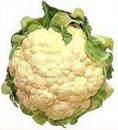Showing Food Cauliflower
| General Information | |||||||||||||||||||||||||||||||||
|---|---|---|---|---|---|---|---|---|---|---|---|---|---|---|---|---|---|---|---|---|---|---|---|---|---|---|---|---|---|---|---|---|---|
| Name | Cauliflower | ||||||||||||||||||||||||||||||||
| Scientific Name | Brassica oleracea var. botrytis | ||||||||||||||||||||||||||||||||
| Description | Cauliflower is one of several vegetables in the species Brassica oleracea, in the family Brassicaceae. It is an annual plant that reproduces by seed. Typically, only the head (the white curd) is eaten. The cauliflower head is composed of a white inflorescence meristem. Cauliflower heads resemble those in broccoli, which differs in having flower buds. Its name is from Latin caulis (cabbage) and flower. Brassica oleracea also includes broccoli, brussels sprouts, cabbage, collard greens, and kale, though they are of different cultivar groups. Cauliflower is low in fat, low in carbohydrates but high in dietary fiber, folate, water, and vitamin C, possessing a high nutritional density. Cauliflower can be roasted, boiled, fried, steamed, or eaten raw. | ||||||||||||||||||||||||||||||||
| Primary ID | FOOD00031 | ||||||||||||||||||||||||||||||||
| Picture |  | ||||||||||||||||||||||||||||||||
| Classification | |||||||||||||||||||||||||||||||||
| Group | Vegetables | ||||||||||||||||||||||||||||||||
| Sub-Group | Cabbages | ||||||||||||||||||||||||||||||||
| Taxonomy | |||||||||||||||||||||||||||||||||
| Superkingdom | Eukaryota | ||||||||||||||||||||||||||||||||
| Kingdom | Viridiplantae | ||||||||||||||||||||||||||||||||
| Phylum | Streptophyta | ||||||||||||||||||||||||||||||||
| Class | Magnoliopsida | ||||||||||||||||||||||||||||||||
| Order | Brassicales | ||||||||||||||||||||||||||||||||
| Family | Brassicaceae | ||||||||||||||||||||||||||||||||
| Genus | Brassica | ||||||||||||||||||||||||||||||||
| Species | oleracea | ||||||||||||||||||||||||||||||||
| Variety | botrytis | ||||||||||||||||||||||||||||||||
| External Links | |||||||||||||||||||||||||||||||||
| ITIS ID | 530957 | ||||||||||||||||||||||||||||||||
| Wikipedia ID | Cauliflower | ||||||||||||||||||||||||||||||||
| Composition | |||||||||||||||||||||||||||||||||
| Compounds |
Processing... | ||||||||||||||||||||||||||||||||
| Macronutrients |
Showing 1 to 6 of 6 entries (filtered from 7 total entries) | ||||||||||||||||||||||||||||||||
| References | |||||||||||||||||||||||||||||||||
| Content Reference | — Saxholt, E., et al. 'Danish food composition databank, revision 7.' Department of Nutrition, National Food Institute, Technical University of Denmark (2008). — U.S. Department of Agriculture, Agricultural Research Service. 2008. USDA National Nutrient Database for Standard Reference, Release 21. Nutrient Data Laboratory Home Page. — Rothwell JA, Pérez-Jiménez J, Neveu V, Medina-Ramon A, M'Hiri N, Garcia Lobato P, Manach C, Knox K, Eisner R, Wishart D, Scalbert A. (2013) Phenol-Explorer 3.0: a major update of the Phenol-Explorer database to incorporate data on the effects of food processing on polyphenol content. Database, 10.1093/database/bat070. — Shinbo, Y., et al. 'KNApSAcK: a comprehensive species-metabolite relationship database.' Plant Metabolomics. Springer Berlin Heidelberg, 2006. 165-181. | ||||||||||||||||||||||||||||||||